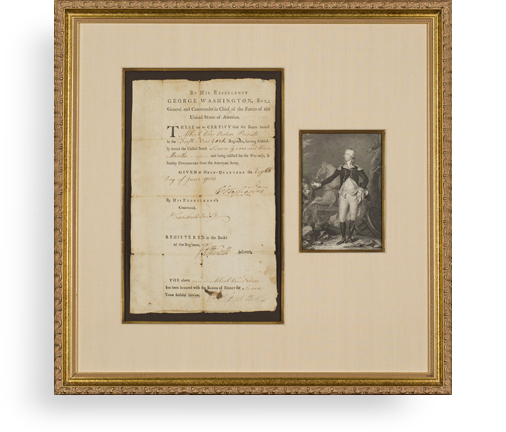George Washington Tracks the War into the Southern Theater

Find "In what manner the British Army is at present disposed...I am anxious to receive intelligence".
In September of 1780, Gen. Benedict Arnold, planning his treason, secured the command of West Point. He then met with British head of intelligence John Andre, and it was agreed that when British troops ascended the river, Arnold was to apply to Washington for reinforcements, and after making a show of resistance,...
In September of 1780, Gen. Benedict Arnold, planning his treason, secured the command of West Point. He then met with British head of intelligence John Andre, and it was agreed that when British troops ascended the river, Arnold was to apply to Washington for reinforcements, and after making a show of resistance, was to surrender the post.
The British would follow by falling upon the approaching American reinforcements, probably led by Washington himself. So, at one blow, Washington’s army was to be ruined and he was to be seized. The plot was discovered when on September 23, Andre was stopped near Tarrytown, N.Y. by some American militiamen, and suspicious papers were found upon his person.
Fortunately, at this point Maj. Benjamin Tallmadge returned from a scouting foray and saw the papers. He was Washington’s intelligence chief and had established a strong and successful chain of spies throughout the New York area, thus creating an early secret service in America. Tallmadge was very suspicious of Andre and sent a letter with the found papers to Washington, who appreciated their significance.
Thus Arnold’s plot was foiled in part through Tallmadge’s quick thinking. Arnold escaped but Andre was hanged as a spy on Oct. 2. With Arnold now a British general, and suspecting that the British had planned additional military moves in conjunction with his treason, Washington watched and waited for British action. This was expected in or around the Hudson River Valley, on Long Island or in New Jersey. But the British were mainly looking South.
By order of the British commander in America, Gen. George Clinton, on October 16, 1780, Gen. Alexander Leslie, with several English regiments, left New York for the Southern states. This was a considerable force, and word got back to Washington that British troops were on the move. He needed to determine the significance of the movement, and immediately wrote Tallmadge, instructing him to gather information. In his letter, he first dealt with a problem of Tallmadge’s, that the gold coins that he had been given to fund his activities had been shaved, and were worth less than the amount he required.
George Washington autograph on a Letter Signed, Head Quarters near Passaic Falls (New Jersey), October 20, 1780, to Tallmadge. “I have recd your favor of the 17th. If you will return the five pieces of Gold which are too light, I will replace them. I have not the means of weighing them, and therefore may be again mistaken. Be pleased to find an appointment as soon as possible of obtaining the following information, with accuracy. Of what number of Men and of what Corps the late embarkation consisted? Whether Sir Henry Clinton went with them? Whether a reinforcement arrived lately from Europe – the number, and whether of which Corps or Recruits? In what manner the British Army is at present disposed – designating as nearly as possible the Corps which lay at the different places? I am anxious to receive intelligence of the foregoing particulars, and you will oblige me by obtaining it Speedily.”
The letter is in the hand of Col. Tench Tilghman, Washington’s aide-de-camp, and has Washington’s bold signature. It is published in The Writings of George Washington, which states the “five pieces of Gold” mentioned by Washington were for “secret services.” Washington had every reason to be anxious for information on the British embarkation. Were the troops few in number or a significant force, did Gen. Clinton go with them, and had they been recently reinforced? What was the British Army’s present disposition? This information was crucial for both attack and defense and would disclose which positions of Washington were in danger and the destination of the embarkees.
The answers Washington received would have indicated the course of the war, as it moved from North to South. Leslie’s men, including some German troops but not accompanied by Gen. Clinton, reported to Lord Cornwallis, where they made up a significant percentage of his force. They participated in Cornwallis’s entire campaign through North Carolina and Virginia and surrendered with him at Yorktown. An extraordinary letter from Washington to his spymaster, relating both to Arnold’s treason and the movement of the war to the Southern theater, where it culminated in victory.

Frame, Display, Preserve
Each frame is custom constructed, using only proper museum archival materials. This includes:The finest frames, tailored to match the document you have chosen. These can period style, antiqued, gilded, wood, etc. Fabric mats, including silk and satin, as well as museum mat board with hand painted bevels. Attachment of the document to the matting to ensure its protection. This "hinging" is done according to archival standards. Protective "glass," or Tru Vue Optium Acrylic glazing, which is shatter resistant, 99% UV protective, and anti-reflective. You benefit from our decades of experience in designing and creating beautiful, compelling, and protective framed historical documents.
Learn more about our Framing Services








































































































